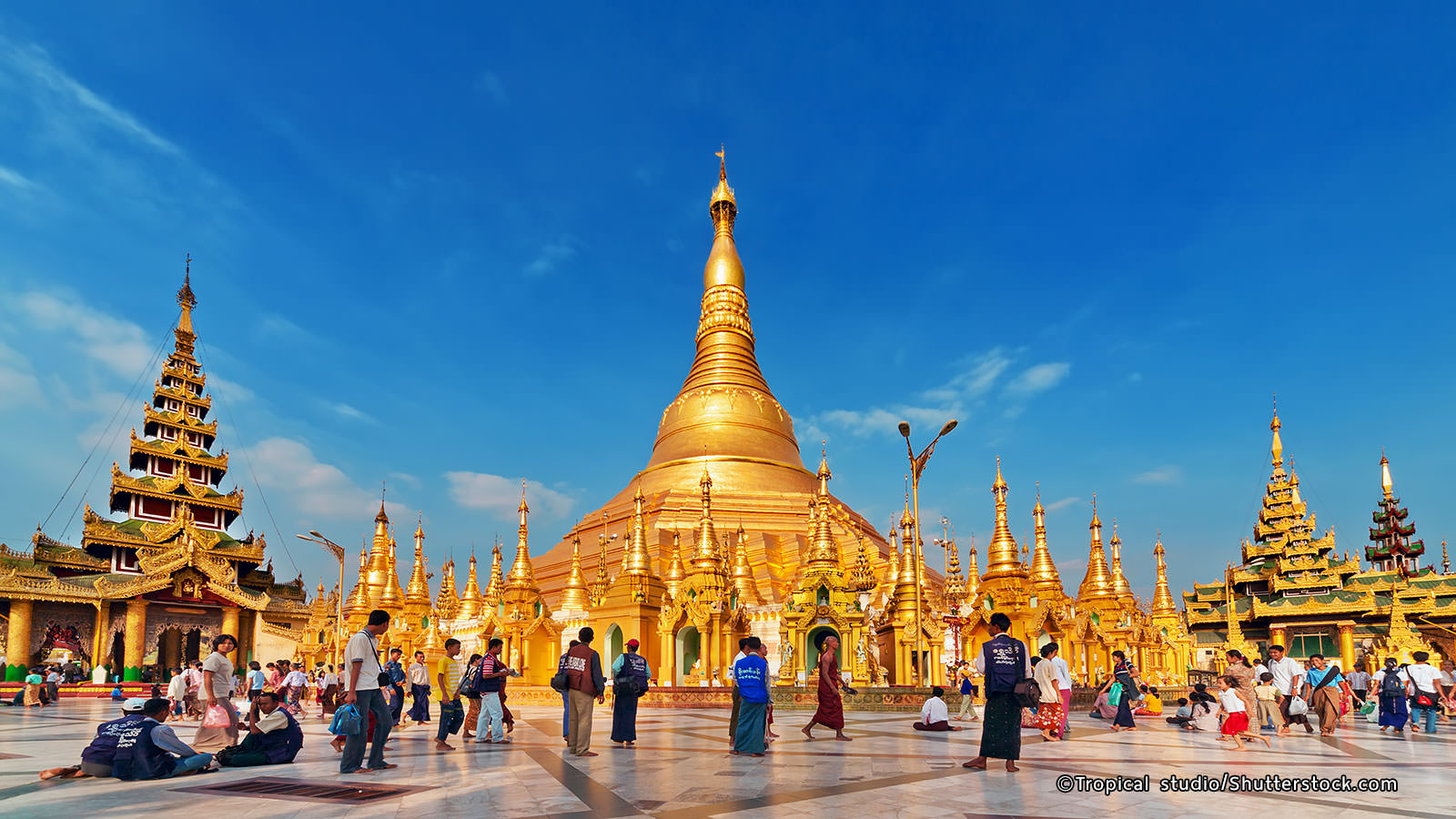
The traditional art is representing for the standard of country. Some people believe that the traditional Myanmar puppets have been carried with the culture of this country for thousands of years, perhaps from the Bagan Dynasty since the 11th century. This very interesting and very deeply art of the people of Myanmar because of the technique of performance. Wooden puppets were a major form of entertainment for Burmese royal families ever since the 15th century. Human performers were not allowed to wear full regalia of a king or robes of a monk in their plays. Puppets were allowed to be fully dressed as their characters. Traditional Burmese puppet theatre (yoke thay) dates between the 15th century and 19th century it reached the peak of its popularity, but after that other types of -lighter- entertainment became more popular. The name 'ah myint thabin' (high performance) refers to the fact that the puppets perform on a raised platform, contrary to human dancers who perform on ground level (ah naint thabin). It was made by wooden with sculpture art and then polished with natural dye and polish liquid and then paint it as the category of character. For each puppet usually made with 17 to 19 pieces of wood with 11 strings. There are 28 main characters in traditional Burmese puppet shows, ranging from gods, animals, monsters and royals. The entire process requires around twenty days of production from start to finish. Strings are also attached to every joint, including the puppet’s eyebrows in order to allow for more flexibility during each performance. Professional puppet-makers from Mandalay are becoming rare. It is one of the main duties of our people to maintain that precious art.
ရိုးရာအနုပညာသည်နိုင်ငံ၏အဆင့်အတန်းကိုကိုိယ်စားပြုနေပါသည်။မြန်မာ့ရိုးရာရုပ်သေးပညာကိုလွန်ခဲ့သောနှစ်ထောင်ပေါင်းများစွာကအေဒီ(၁၁)ရာစုပုဂံခေတ်ကတည်းကပင်လက်ဆင့်ကမ်းလာကြသည်ဟုယုံကြည်ကြပါသည်။မြန်မာလူမျိုးတို့၏အဆင့်အတန်းမြင့်မားပြီးစိတ်ဝင်စားစရာကောင်းပြီးအလွန်နက်နဲသောဖျော်ဖြေမှုအနုပညာတစ်ခုဖြစ်ပါသည်။(၁၅)ရာစုနှစ်တွင်သစ်သားဖြင့်ပြုလုပ်ထားသောရုပ်သေးရုပ်များသည်တော်ဝင်မိသားစုများအကြားအဓိကဖျော်ဖြေစရာဖြစ်ခဲ့ပါသည်။သရုပ်ဆောင်ရာတွင်မြင့်မြတ်သောဘုရင့်အသုံးအဆောင်ပုံစံများဖြစ်သောနန်းဝတ်၊နန်းစားများနှင့်ဘုန်းကြီးသင်္ကန်းများကိုဝတ်ဆင်ခွင့်မရှိသောကြောင့်ရုပ်သေးများကိုပုံဖော်ပြီး၎င်းတို့နေရာတွင်သရုပ်ဆောင်ကြရသည်။ရုပ်သေးပြဇာတ်များသည်(၁၅)ရာစုနှင့်(၁၆)ရာစုကြားတွင်လူကြိုက်များသောခေတ်အခါသို့ရောက်ရှိခဲ့၍နောက်ပိုင်းတွင်တခြားပေါ့ပါးသောအစီအစဉ်များကိုပို၍လူကြိုက်များလာကြပါသည်။စင်ပေါ်တွင်ရုပ်သေးကပြခြင်းကိုအမြင့်သဘင်ဟုခေါ်၍မြေပြင်ပေါ်တွင်လူများသရုပ်ဖော်ကပြခြင်းကိုအနိမ့်သဘင်ဟူ၍အမျိုးအစားခွဲခြားထားပါသည်။ရုပ်သေးရုပ်များအားသစ်သားဖြင့်ထွင်းထုထားပြီးသဘာဝဆိုးဆေးဖြင့်အရောင်တင်ကာ၎င်းတို့၏ဇာတ်ရုပ်အလိုက်ဆေးခြယ်သရုပ်ဖော်ကြပါသည်။ရုပ်သေးရုပ်တစ်ရုပ်တွင်သစ်သားအပိုင်းအစပေါင်း(၁၇)ခုမှ(၁၉)ခုအထိပါဝင်ပြီးကြိုးပေါင်း(၁၁)ကြိုးပါရှိပါသည်။မြန်မာ့ရုပ်သေးတွင်စုစုပေါင်းအရုပ်(၂၈)ရုပ်ရှိပြီးနတ်ရုပ်များ၊ဘီလူးရုပ်၊တိရစ္ဆာန်ရုပ်များနှင့်ဘုရင်အရုပ်များပါဝင်ပါသည်။ရုပ်သေးကရာတွင်လိုက်လျောညီထွေဖြစ်စေရန်ရုပ်သေးရုပ်၏မျက်ခုံးအပါအဝင်ဆက်ထားသောအဆက်အားလုံးကိုကြိုးဖြင့်တွယ်ဆက်ထားပါသည်။ရုပ်သေးပြုလုပ်သူပညာရှင်အများစုသည်မန္တလေးမြို့ပတ်ဝန်းကျင်မှဖြစ်ကြပါသည်။ထိုကဲ့သို့အဖိုးထိုက်တန်လှသောအနုပညာကိုထိန်းသိမ်းခြင်းမှာကျွနုပ်တို့လူမျိုးတို့၏အဓိကတာဝန်တစ်ခုဖြစ်ပါသည်။
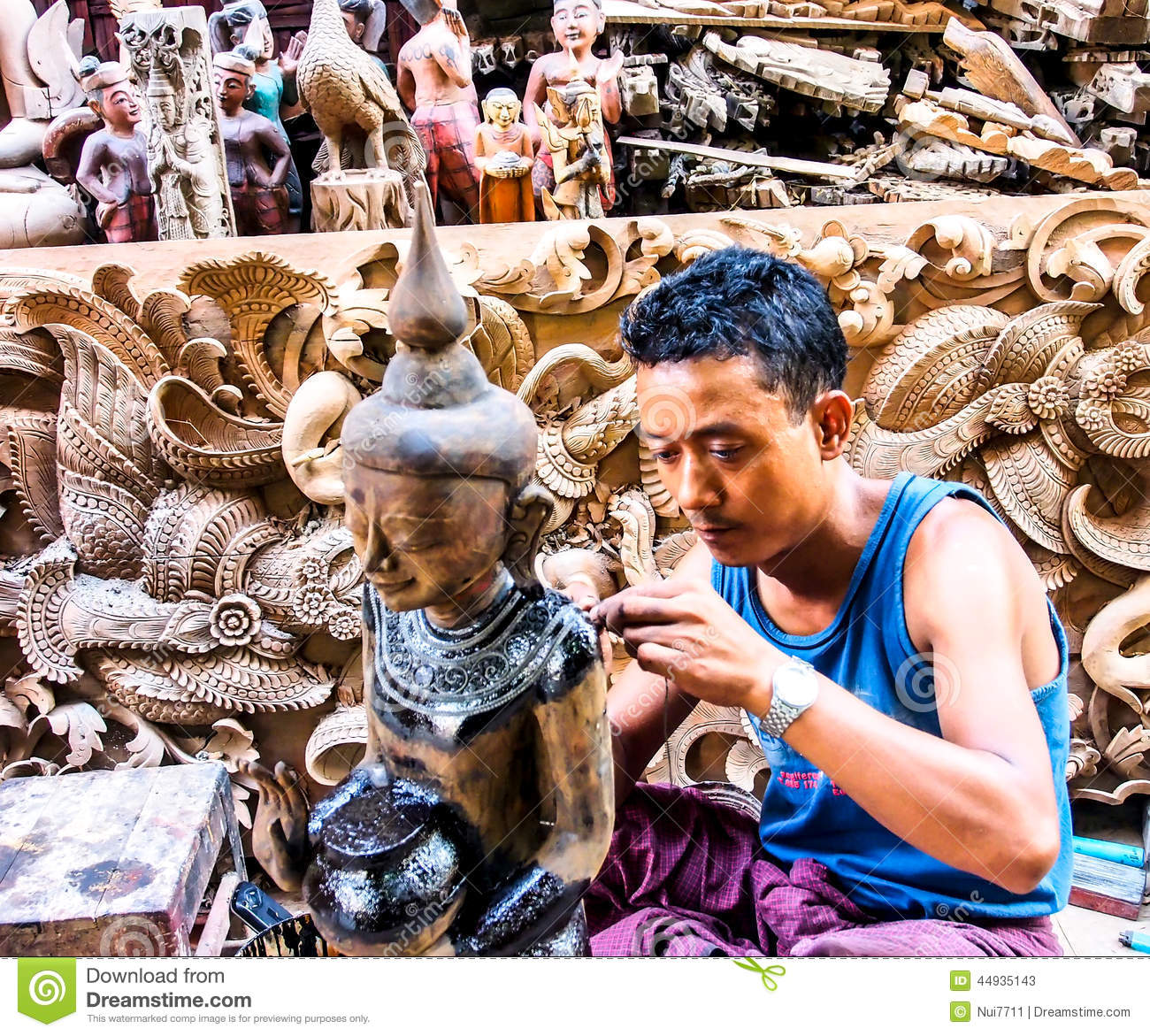
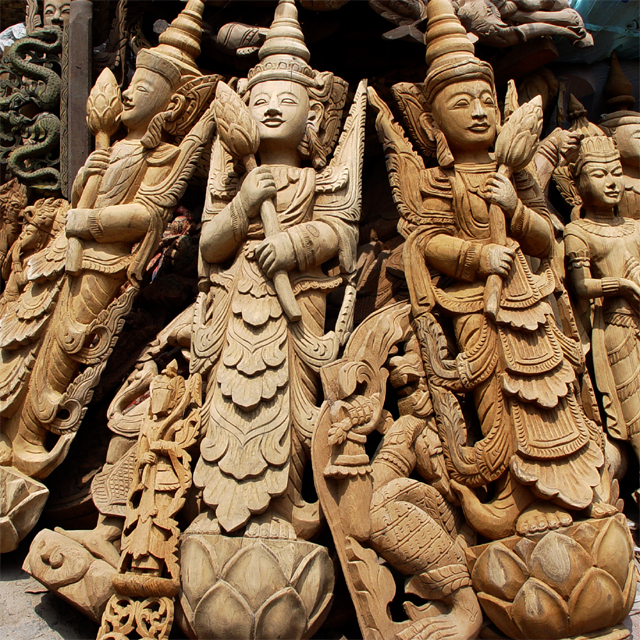
Wood Carving is one of the biggest and locally famous products of Myanmar and including the “Ten Flowers Arts”. The art of Sculpture means the one which produces figures and floral designs made of wood or ivoy. Myanmar’s traditional sculpture emerged before the Bagan period and it improved in the middle of Bagan Era. Myanmar’s sculpture bases the religion of Buddhism which arrived from Southern India in the 11th century A.D. Most of the wood sculptures of Bagan and Ava periods have been lost under various circumstances and only a few are left today. Till now the families from the southern part of Mandalay work as wood carvers as their profession. Most of Myanmar handicrafts come from Mandalay. The workshops are near the Mahar Myatmuni Temple and in Tampawaddy. Many different figures such as religious themes, Buddha Images, figure of human beings, animals and floral designs are produced.
ပန်းပုပညာသည်ပန်းဆယ်မျိုးအနုပညာထဲတွင်ပါဝင်သောမြန်မာနိုင်ငံ၏အကျော်ကြားဆုံးနှင့်အထင်ရှားဆုံးပညာဖြစ်ပါသည်။ပန်းပုထုခြင်းအနုပညာရပ်မှာသစ်သားကိုအသုံးပြု၍ရုပ်ပုံများ၊ပန်းအလှဒီဇိုင်းများကိုပြုလုပ်ခြင်းဖြစ်ပါသည်။မြန်မာ့ပန်းပုပညာသည်ပုဂံခေတ်မတိုင်မီကပင်ပေါ်ထွက်လာပြီးပုဂံခေတ်အလယ်ပိုင်းတွင်ဖွံ့ဖြိုးတိုးတက်လာခဲ့ပါသည်။မြန်မာ့ပန််းပုပညာသည်အေဒီ(၁၁)ရာစုတွင်အိန္ဒိယနိုင်ငံတောင်ပိုင်းမှရောက်ရှိလာသောဗုဒ္ဓဘာသာလူမျိုးများ၏ဘာသာရေးကိုအခြေခံ၍ထွန်းကားလာခဲ့ပါသည်။ပုဂံခေတ်နှင့်အင်းဝခေတ်ပန်းပုလက်ရာအများစုမှာအမျိုးမျိုးသောအကြောင်းရင်းများကြောင့်ပျောက်ဆုံးသွားခဲ့ပြီးအနည်းငယ်သာလျှင်ကျန်ရှိပါသည်။မန္တလေးမြို့၏တောင်ဘက်တွင်နေထိုင်သောမိသားစုများသည်ယနေ့တိုင်အောင်ပန်းပုထု၍ပန်းပုပညာဖြင့်အသက်မွေးကြပါသည်။မြန်မာနိုင်ငံ၏လက်မှုပညာအများစုသည်မန္တလေးမှထွက်ပေါ်လာကြသည်။ပန်းပုလုပ်ငန်းအများစုကိုမဟာမြတ်မုနိဘုရားအနီးနှင့်တမ္ပဝတီတွင်တွေ့နိုင်ပါသည်။အမျိုးမျိုးသောရုပ်တုများဘာသာရေးဆိုင်ရာပစ္စည်းများ၊ဗုဒ္ဓရုပ်ပွားတော်များ၊လူပုံတူရုပ်တုများ၊တိရစ္ဆာန်ပုံများနှင့်ပန်းဒီဇိုင်းများကိုပြုလုပ်ကြပါသည်။
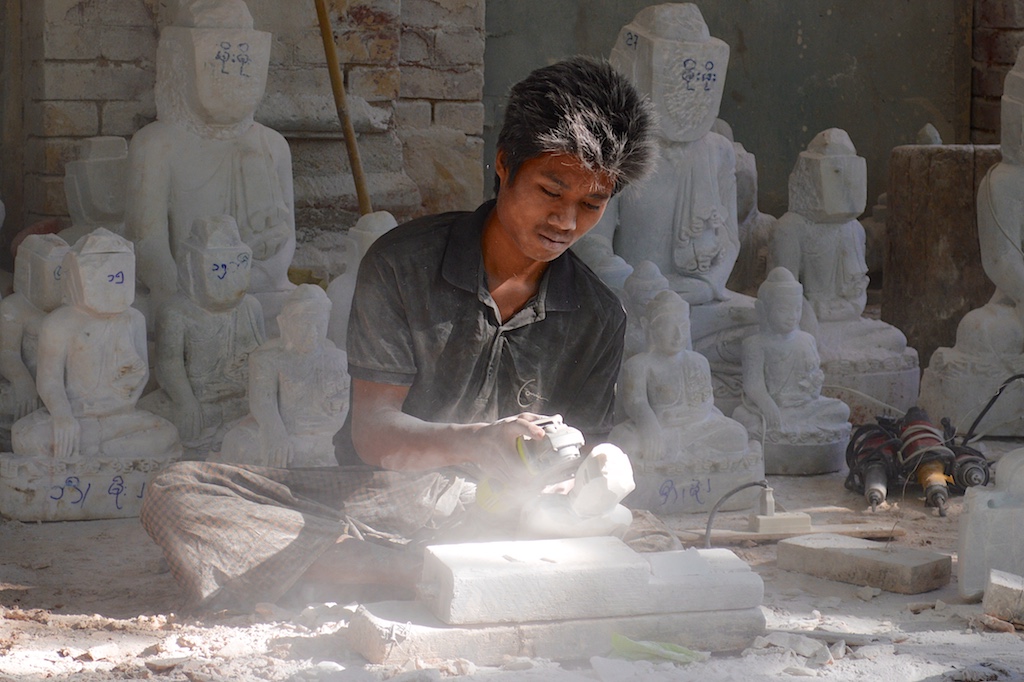
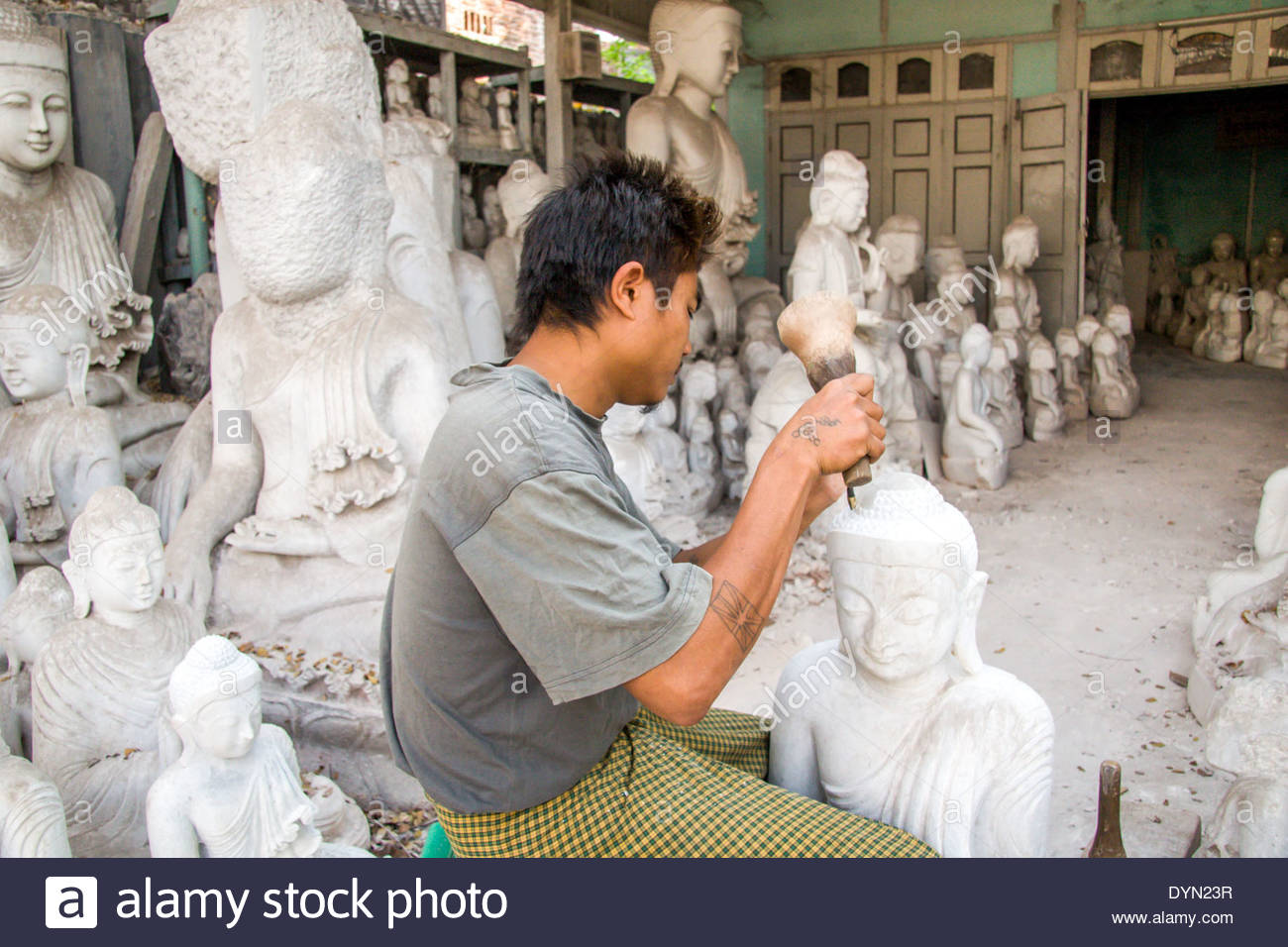
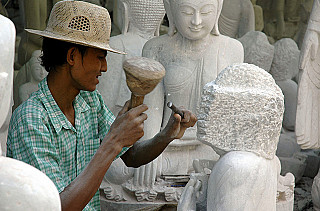
Stone Carving is one of the hands making workshop in Mandalay. It is including the Myanmar Traditional Arts “Ten Flower”. This kind of art is widely practiced throughout Myanmar today and it has become the pride and honor of Myanmar people. The Marble carving workshop is near Mahamuni Pagoda. Marble quarry are about 35 miles (56km) north of Mandalay. Traditionally the artisans in this country make Buddha images stock for Sima, flag poles, pillars, animal decorations, circular flat stone, pestle and mortar and table. Marble craftsmanship is an interesting topic. It is commonly said that an auspicious day and time have to be chosen carefully by an astrologer before the artisans carve the very first marble images. The stone which is used to create the figures must be blessed with a sprinkling of holy water and homage offering. After the solemn rituals have been finished, the master marks out the outline and make the first cut. Then the rough cut will be the responsibility of the experienced apprentices. The master will take over the final carving stages, under his tools the marble peels away as if it were soft wax. In Mandalay, workshops line Kyauk Sitt Than, literally meaning “Stone Carving Road”, is the main place for distributing stone products.
ကျောက်ဆစ်လုပ်ငန်းသည်မြန်မာ့ရိုးရာပန်းဆယ်မျိူးအနုပညာများတွင်ပါဝင်သောမန္တလေးမြို့၏လက်မှုအနုပညာများထဲမှတစ်ခုဖြစ်ပါသည်။ကျောက်ဆစ်ပညာသည်ယနေ့မြန်မာနိုင်ငံတွင်ကျယ်ပြန့်စွာအသုံးပြုနေသောအနုပညာဖြစ်ပြီးမြန်မာလူမျိုးတို့၏ဂုဏ်ကိုမြှင့်တင်ပေးသောပညာရပ်တစ်ခုဖြစ်ပါသည်။ကျောက်ဆစ်တန်းသည်မဟာမြတ်မုနိဘုရားအနီးတွင်တည်ရှိပါသည်။စကျင်ကျောက်များကိုမန္တလေးမြို့၏မြောက်ဘက်(၃၅မိုင်)၅၆ကီလိုမီတာအကွာစကျင်ကျောက်ကျင်းများမှရှိပါသည်။မြန်မာနိုင်ငံမှရိုးရာကျောက်ဆစ်ပညာရှင်များသည်ဗုဒ္ဓရုပ်ပွားတော်များ၊တံခွန်တိုင်များ၊တိုင်လုံးများ၊တိရစ္ဆာန်ရုပ်ပုံများ၊ကျောက်ပြားဝိုင်းများ၊ငရုတ်ကျည်ပွေ့နှင့်ငရုတ်ဆုံများ၊စားပွဲခုံများကိုထွင်းထုကြပါသည်။စကျင်ကျောက်အားထုလုပ်သောကျောက်ဆစ်ပညာရှင်များတွင်စိတ်ဝင်စားစရာအချက်တစ်ခုရှိပါသည်။ကျောက်ဆစ်ပညာရှင်များသည်ပထမဦးစွာကျောက်တုံးအားမထုဆစ်မီနက္ခတ်ဗေဒပညာရှင်ထံမှနေ့ရက်ကောင်းကိုဂရုတစိုက်ရွေးချယ်ရပါသည်။မြင့်မြတ်သောအရုပ်များဖန်တီးရာတွင်ဆုတောင်းမေတ္တာများပို့သပြီးပရိတ်ရေများဖြင့်ပက်ဖျန်းရပါသည်။ထိုကဲ့သို့ရိုးရာအစဉ်အလာများပြုလုပ်ပြီးနောက်ပထမဦးစွာခေါင်းဆောင်မှထုလုပ်မည့်အဓိကအစိတ်အပိုင်းများကိုမှတ်သားရသည်။ထို့နောက်ပညာသင်၏အတွေ့အကြုံအရအကြမ်းထွင်းထုရပါသည်။ပညာရှင်မှနောက်ဆုံးအချောထည်အဆင့်အားပြုလုပ်၍ဖယောင်းပျော့ရှိပါကကျောက်သားအားခွာပစ်ရပါသည်။မန္တလေးရှိအဓိကကျောက်ဆစ်ပစ္စည်များထွက်ရှိသောနေရာကိုကျောက်ဆစ်တန်းဟုခေါ်ပါသည်။